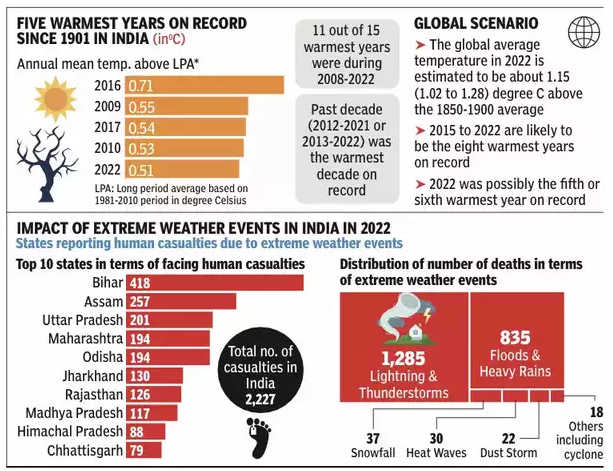| Events |
Description |
Example |
| Heatwaves |
- A heatwave occurs when the maximum and the minimum temperatures are unusually hot over a three-day period at a location. This is considered in relation to the local climate and past weather at the location.
- In India, Heat Waves typically occur between March and June, and in some rare cases even extend till July.
|
- According to the European Space Agency in june 2023, Italy’s islands of Sicily and Sardinia could experience their hottest-ever temperature, with a predicted high of 48 degrees Celsius (118F) — potentially the hottest temperatures ever recorded in Europe.
- In the middle of April a heatwave swept over China, India, Thailand, Laos, Bangladesh, and more countries across the Asian continent, with temperatures ranging from 38 degrees to 45 degrees Celsius — breaking temperature records in over a dozen countries.
|
| Wildfire |
- Wildfire, also called forest, bush or vegetation fire, can be described as any uncontrolled and non-prescribed combustion or burning of plants in a natural setting such as a forest, grassland, brush land or tundra, which consumes the natural fuels and spreads based on environmental conditions (e.g., wind, topography).
|
- Canada: Canada is currently experiencing its worst ever wildfire season, largely due to an extreme dry period followed by a heatwave.
|
| Droughts |
- Drought is a prolonged dry period in the natural climate cycle that can occur anywhere in the world.
- It is a slow-onset disaster characterized by the lack of precipitation, resulting in a water shortage.
|
- From North America to Europe to China, vast swaths of the Northern Hemisphere experienced extreme drought in the summer of 2022, straining water resources, ruining crops, and priming the landscape for perilous wildfires.
- Horn of Africa drought, 2020-2023: A three-year drought in the Horn of Africa, one of the world’s most impoverished regions, has caused crops to wither, water to disappear, and livestock to starve in large parts of Kenya, Somalia and Ethiopia.
|
| Cold Snaps |
- A cold snap is a very sudden drop in temperature as opposed to a cold spell (Spell means a length of time), and a cold wave (a wave comes gradually and grows till it breaks).
- It have a multifaceted impact on not just human lives, but the Earth’s systems as a whole.
- Indian Meteorological Department (IMD) declares a cold wave when the minimum temperature is equal to or less than 10 degrees Celsius at a weather station in the plains and is 4.5-to 6.4 degrees Celsius below the normal temperature for that period.
|
- In 2023, temperatures in the city of Mohe in northern China plummeted to minus 53 degrees Celsius (minus 63.4 degrees Fahrenheit), the lowest temperature the country has ever recorded.
|
| Tropical Cyclones |
- A tropical cyclone is a rapid rotating storm originating over tropical oceans from where it draws the energy to develop.
- It has a low pressure centre and clouds spiraling towards the eyewall surrounding the “eye“, the central part of the system where the weather is normally calm and free of clouds.
- According to the IPCC, these have become more frequent over the last four decades. Furthermore, they are proving more destructive as they result in higher category hurricanes.
|
- Tropical Storm ‘Mawar’ affected Guam, the Philippines, Taiwan, and Japan at the end of May and early June.
- It is reported as the strongest tropical cyclone globally so far in 2023 and the strongest northern hemisphere cyclone ever recorded in May.
- Cyclone Mocha Myanmar: It proved to be one of the strongest cyclones to ever hit the region.
- The storm led to immense destruction, killing an estimated 145 people.
- According to the UN, the cyclone impacted 800,000 people overall.
|
| Torrential rains |
- Torrential rain, or a torrential downpour, is any amount of rain that is considered especially heavy.
|
- Asia in 2023 has been hit by extreme weather conditions, with South Korea facing heavy rains causing floods and landslides, resulting in 37 deaths and nine people missing.
- Northern Japan also experienced deadly floods, claiming the life of a man in a submerged vehicle.
- In northern India, relentless monsoon rains have killed at least 90 individuals, exacerbating the region’s already scorching heat.
|
| Flood and Flash Flood |
- Flood: An overflow of water onto normally dry land. The inundation of a normally dry area caused by rising water in an existing waterway, such as a river, stream, or drainage ditch. Ponding of water at or near the point where the rain fell.
- Flash flood: A flood caused by heavy or excessive rainfall in a short period of time, generally less than 6 hours. Flash floods are usually characterized by raging torrents after heavy rains that rip through river beds, urban streets, or mountain canyons sweeping everything before them.
- Flooding is a longer term event than flash flooding: it may last days or weeks.
|
- Pakistan floods, 2022: Major flooding caused by record monsoon rains claimed the lives of nearly 1,500 people during the summer of 2022, with millions more affected by clean water and food shortages.
- The floods left a third of Pakistan underwater.
- The country received more than three times its usual rainfall in August, making it the wettest August since 1961.
- Increases in both extreme precipitation and total precipitation have contributed to increases in severe flooding events in certain regions.
|
![]() 19 Jul 2023
19 Jul 2023

 Image Credit: TOI
Image Credit: TOI